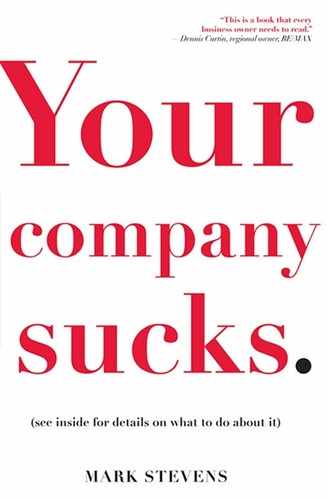warning.
What is Mark Stevens talking about? My company sucks? Maybe his does. But who the hell is he to mouth off like that?
Good questions. They’re the same ones I (Mark Stevens) would ask. So I guess, given that I started this, I have to answer them, and I will. I’ve always been advised not to start what I couldn’t finish.
But allow me to issue this warning first: the truth in these pages is going to come at you like a blast from a double-barrel shotgun—so brace yourself. I am writing this book because, in the past, my company has sucked. And it will suck again if I don’t make damn certain that there is a near-religious zeal in our company culture to achieve excellence—to provide a thrilling experience for the customer—so much so that I am utterly dissatisfied if I fail to hit the standard I’m on a mission to achieve. I, like you, must be forever restless, relentless, and driven. I have seen my company go from sucking to soaring, and I want to help you get there, too.
As the CEO of a marketing and management consulting firm, my job is to speed the upward trajectory and reverse the down cycles of my company’s clients’ businesses. We work with companies of all sizes, in all stages of the business cycle:
- Startup
- Runaway growth
- Dead end
- Roadblock
- Slow decline
- Free fall
In the process, I see strong, smart, talented, gutsy, and creative men and women at the helm of their companies—each with their money and egos hanging in the balance—struggling at times to eliminate the flaws that threaten the enterprises they have built. Some are tottering on the brink of failure or heading into a downward spiral.
Interestingly, nearly all business managers I talk to believe the challenges and obstacles they face are unique. It’s as if they are having an out-of-body experience that no one else has ever experienced in the history of commerce and capitalism. But they are not unique at all. Although it appears from a distance that there are a thousand reasons for a company’s failings and shortcomings—all unique to the individual enterprises—the reasons, as different as they may appear to be on the surface, fall into four major categories:
- Rudderless Leadership
- The Lust-to-Lax Syndrome
- Incompetence
- Conventional Thinking
These four unhealthy traits manifest themselves in many forms and develop into a pattern that either never goes away or returns over and over again like an unrelenting plague. Let me expound a little on what each entails:
- Rudderless Leadership: Management has lost command and control of the business. Employees act on the basis of their own agendas, are accountable to no one, engage in a set of actions that are random, disconnected, and devoid of a cohesive strategy. What looks like a company no longer qualifies for that distinction. It is better viewed by the reality of what it has become: a group of people working under the same roof but rarely if ever moving in the same direction.
- The Lust-to-Lax Syndrome: Existing customers are taken for granted by a management team hyperfocused on attracting new business into its camp at the expense of those patrons who are the most loyal to it. In time, the former loyalists leave, frustrated by their stepchild status and the service that goes with it. That makes the business a leaky boat, with everyone bailing frantically to stay above water. New business is vital, but a company’s most important and valuable asset is its customer base. Treat them with indifference and your company truly sucks.
- Incompetence. They do not know how to generate return on investment (ROI) on their marketing initiatives. They spend on programs that fail to grow the business or (having reached the breaking point with marketing that barely moves the needle) they do nothing to grow the business at all. This preventive move never produces results. You don’t make money by saving money; you make money by investing money wisely. Those who have stopped trying to make money through investing always have companies that are stuck in neutral.
- Conventional Thinking. An aggressive competitor moves into the market and immediately seizes market share. The manager of the resident business complains about the “carpetbagger” but does little to defend the company’s position. Anger and frustration lead not to a determination to succeed against any and all odds but to a devastating paralysis. The hard fact is that the free market is not fair—it is a competitive war zone where those who can face adversity, revise their strategy, and move forward always prevail over time. Move forward by thinking and acting in an innovative, even iconoclastic fashion. Don’t be trapped by conventional thinking.
Fighting those patterns and understanding how to move beyond satisfying your customers to thrilling is what this book is all about. These pages will instruct you on:
- How to identify your company’s negative qualities—you may have only one or you may have all four;
- When to stop blaming everyone and everything but yourself;
- What works to engineer U-turns in company performance and what fails because it is simply putting lipstick on a pig;
- How to know when you’re in denial; and, most important,
- How to challenge convention and take the often drastic steps that need to become standard operating procedures at your company.
The goal, my fellow entrepreneurs and capitalists, is to put our companies into orbit for a lifetime of scalable and sustainable growth—to go from sucking to soaring. It’s time to declare war against ourselves, to go on the offense to attack those areas that bring us down, and then launch our businesses skyward by captivating our customers—to thrill them so much they wouldn’t dream of going anywhere else. Everything else is a treadmill to nowhere.
